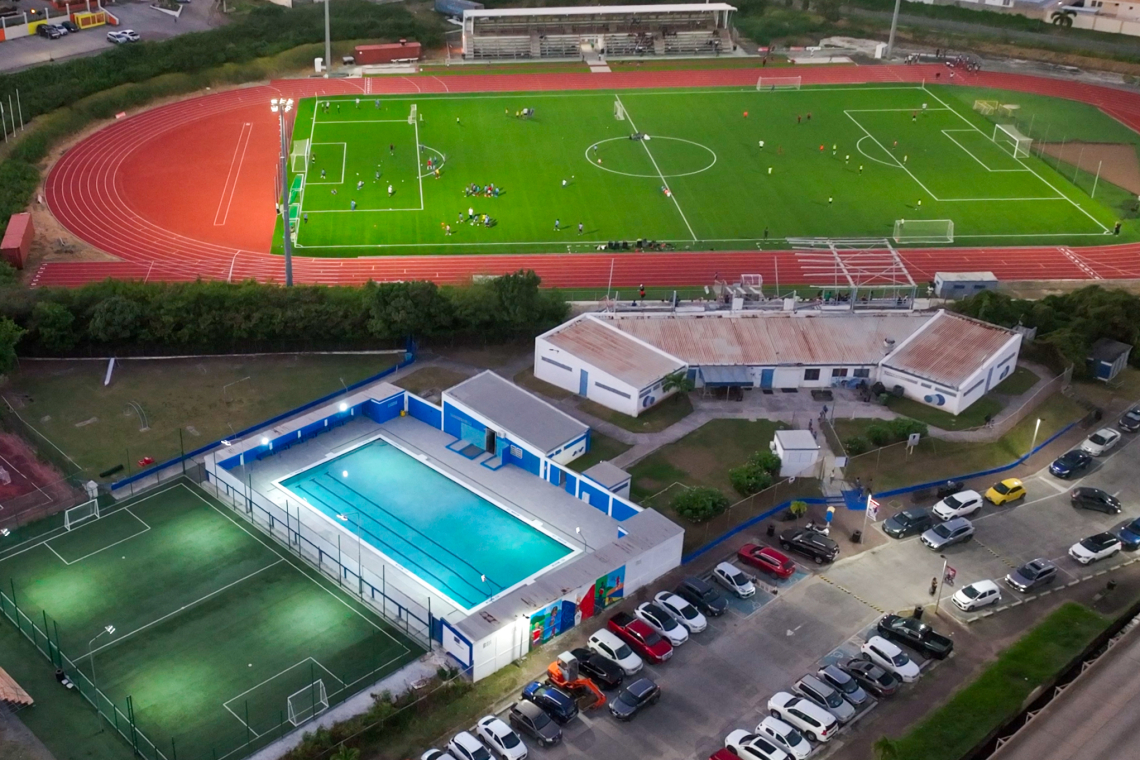By Rajesh Chintaman
Two eucalyptus trees standing in front of the LB Scott Sports Auditorium are quickly making a comeback. Once the subject of community concern after being heavily trimmed in September, their branches have started to sprout new green leaves – a sign that the National Sports Institute’s (NSI) effort to preserve them, rather than remove them, is paying off.
The decision to cut the trees back was never meant as destruction, says NSI Director Jisk Goslinga, but as a necessary step to save them and protect the facility they shade. “The trees were damaging the building, the roof, the shutters, the gutters, even the walls,” he explained. “And because the auditorium also serves as a hurricane shelter, we had to consider safety above all else. In hurricane season, branches hitting the structure could have caused even more serious damage.”
Rather than remove the eucalyptus trees entirely, NSI opted for a controlled trim designed to help both the trees and the building coexist. “They had never been maintained since they were planted, maybe 12 to 15 years ago,” Goslinga said. “We cut them back to a manageable level so they could recover, and so we can maintain them more easily in the future.”
In the weeks since, the trees have re-sprung, showing healthy new growth – a sign that the effort to save them was not in vain. For Goslinga, that regrowth underscores the institute’s broader philosophy: Maintaining safety and functionality while preserving the natural character of the spaces it manages.
He acknowledges, however, that such decisions are never simple. NSI’s long-term plan for the auditorium includes a full renovation of its exterior, from structural repairs to updated signage and landscaping. “We definitely want to add more trees around the building where possible,” he said. “But we have to be smart about placement too close to the road or the structure, and the same problems return.”
The trimming of the LB Scott trees, however, speaks to a larger issue. On an island where concrete often pushes out greenery, public facilities such as sports complexes are among the few places where nature could be more deliberately integrated.
Goslinga acknowledges that responsibility and sees opportunity: “Sports facilities are places where people come together. Through sports, we want to build national pride and unity, and part of that is showcasing our own beauty and culture. Adding trees, creating shade, planting fruit, it all adds to the experience.”
That ambition is also written into NSI’s new three-year strategic plan, adopted in February. Among its sustainability objectives are commitments to reduce single-use plastics, repurpose materials like artificial turf and, crucially, to enhance greenery. The plan calls for planting fruit trees and other local vegetation around facilities to provide shade, promote biodiversity, and reflect the island’s heritage.
Goslinga said some of this has already begun. “We already have a large number of small palm trees growing, waiting to be planted. At Raoul Illidge, for example, we have this hillside around the track that could become a green mount, full of fruit trees and plants. That’s something we really want to pursue.”
But as he points out, greening is not always straightforward. Fallen leaves damage synthetic tracks and pool pumps; roots creep into drainage systems; and, in some cases, overgrown hedges create blind spots for criminal activity. “Every addition has to be strategic,” he said. “If you put a tree right next to a court or a pool, you create daily maintenance problems. But in parking lots or open areas, greenery can add so much without being a hindrance. It’s about finding that right balance.”
That balance is also tied to resources. NSI manages 12 government-owned facilities, five multi-sport centres, six district courts, and one public multi-sport space, covering nearly 70,000 square meters. With limited budgets, the institute has been forced to prioritise urgent repairs over beautification. “We have a very detailed maintenance plan,” Goslinga explained. “Greenery is part of that, from mowing grass to trimming trees. But every time we add something new, even a tree, we have to factor in the long-term cost of maintaining it. That’s the reality we work with.”
Repairs, for now, remain NSI’s top priority. Years of deferred maintenance, compounded by Hurricane Irma, left many facilities in disrepair. Significant progress has been made: the Raoul Illidge Sports Complex now boasts an international-standard football pitch and track; a new football mini-pitch with expanded community access; and lighting at John Cooper Jose Lake Ballpark has been temporarily restored. Yet bleachers, stands, and secondary amenities remain behind.
“My vision is that in three years, we’ll have the hardware of the core facilities up to standard,” Goslinga said. “After that, we can shift more to the ‘software’ – programs, beautification, and making our facilities more welcoming and green.”
He believes that shift will also define St. Maarten’s sports identity. For Goslinga, greening is not just about shade or aesthetics but about branding the island as a unique sports destination. “When international partners came to build the track, they said, ‘Wow, we’ve never seen a track surrounded by so many green hills.’ That’s something we can stand out with. It’s sports in paradise being active in the Caribbean landscape.”
NSI has even explored partnerships to reinforce this vision. “We considered a project to grow fruit trees with support from funding agencies. It’s still something we’d like to develop, because it ties sports, environment and community together.”
Ambitions extend beyond traditional sports complexes. Goslinga envisions NSI eventually maintaining playgrounds and other public spaces, many of which are currently neglected. “Playgrounds are part of our business. We maintain sports facilities every day, so why not also make public spaces safer, greener, and more inviting?”
The dream, he said, is a multi-use park with a skate park, picnic tables, cultural features, and plenty of trees. “It would be a place where children can play and parents can sit under the shade. That’s the kind of space St. Maarten needs more of.”
In many ways, the two trees at LB Scott are a test case for how NSI balances its dual mandate: safeguarding facilities while enhancing them for the community. “We didn’t want to remove them outright,” he emphasized. “We’re committed to adding more greenery in ways that make sense for safety, maintenance and community use.”
Sports facilities are more than fields and walls; they are gathering places, symbols of pride, and in a small island context, some of the last open spaces where nature and people can meet. The LB Scott trees are safe. The debate they sparked will shape NSI’s work for years to come. As Goslinga put it: “Our ambition doesn’t stop at sports facilities; it’s about creating spaces that are safe, modern, green, and inviting – spaces that reflect who we are as a people.”







